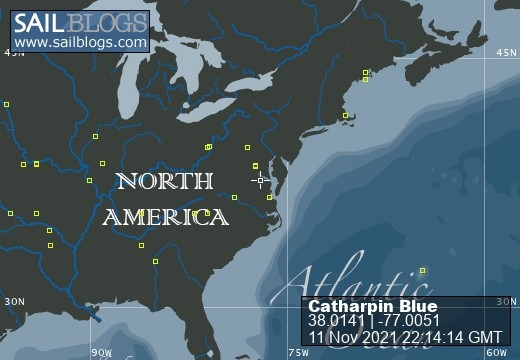
S/V Catharpin Blue
Island Packet 420-62
28 November 2021 | Fairfax, Va
11 November 2021 | Fairfax, Va
10 November 2021 | Altoona, PA
09 November 2021 | Canton, OH
08 November 2021 | Springfield , IL
07 November 2021 | Near Alton, IL (Hartford, IL)
06 November 2021 | Independence, MO
06 November 2021 | St. Joseph’s, MO
05 November 2021 | Topeka, KS
05 November 2021 | Abeliene, KS
04 November 2021 | Kansas
03 November 2021 | Interstate 70 Colorado
02 November 2021 | Moab, UT
01 November 2021 | Fruits, Utah
31 October 2021 | Near Ogden, Utah
30 October 2021 | Utah / Idaho border
29 October 2021 | Glenn’s Ferry, Idaho
28 October 2021 | Boise, Idaho
28 October 2021 | Pendleton, Oregon
27 October 2021 | Columbia River Gourge
Naming Catharpin Blue
03 March 2002 | Deltaville, Va
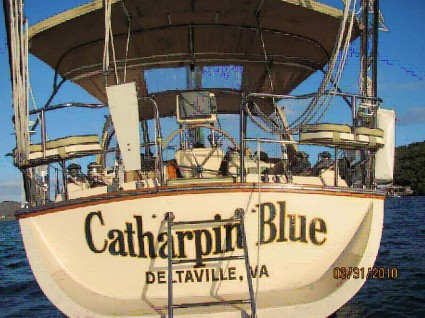
The name "Catharpin Blue" has fostered a nautical history lesson that has continued from 2001, when Sam Fowler bought his IP-420-62, until the present. Having a unique name with nautical roots seemed important in naming the new boat and so we tried to select a nautical based name that had a good chance of being unique. Catharpin Blue has turned out to be truly an unusual name and as time goes on we learn more about its nautical meanings.
At first blush, it seemed a catchy name for the boat that Sam bought to sail on the Blue Water of the ocean. Note that in the picture that the name on the transom suggests blue water ocean waves. As far as Sam knows, there are only two Catharpins - the one in Virginia and one in New York. He also knew that the name was purported to have nautical origins. The people of Catharpin, Va. have speculated that, whereas the "belaying pin" was designed for quick release of a line, the "catharp pin" was likely a locking pin, and had perhaps led to the modern cotter pin. At the least, this was an interesting speculation. As it turns out, this is false based on subsequent findings. What is true is the statement of a fellow Caribbean 1500 rallier we met in 2009 who recalls "catharpin as meaning "pure" or "clean", which might explain why water or a town might be so called".
The catchy words originated when Sam had his swimming pool re-lined in 1998. Living in the country, he has a well which draws water from under Northern Virginia's Bull Run Mountain. It is very pure water and the taste is second to none. After the re-lining, the pool needed to be re-filled with water and Sam used his garden hose. However, that is a slow process and he ordered a water truck to deliver a larger amount. When it arrived, the driver, picking his teeth and probably from the Virginia "backwoods", knowing local legends, took one look at the pool, with the garden hose filling it and commented "Got that wutter from your well, didden ya ?". Sam asked, "yes - why?" The driver said " Look, it's blue! That's Catharpin Blue - best water in the world." And so the story starts. When it came time to name to boat in 2001, we thought of Catharpin Blue, a name with nautical origins that suggested the blue water sailing for which she was intended.
At first blush, it seemed a catchy name for the boat that Sam bought to sail on the Blue Water of the ocean. Note that in the picture that the name on the transom suggests blue water ocean waves. As far as Sam knows, there are only two Catharpins - the one in Virginia and one in New York. He also knew that the name was purported to have nautical origins. The people of Catharpin, Va. have speculated that, whereas the "belaying pin" was designed for quick release of a line, the "catharp pin" was likely a locking pin, and had perhaps led to the modern cotter pin. At the least, this was an interesting speculation. As it turns out, this is false based on subsequent findings. What is true is the statement of a fellow Caribbean 1500 rallier we met in 2009 who recalls "catharpin as meaning "pure" or "clean", which might explain why water or a town might be so called".
The catchy words originated when Sam had his swimming pool re-lined in 1998. Living in the country, he has a well which draws water from under Northern Virginia's Bull Run Mountain. It is very pure water and the taste is second to none. After the re-lining, the pool needed to be re-filled with water and Sam used his garden hose. However, that is a slow process and he ordered a water truck to deliver a larger amount. When it arrived, the driver, picking his teeth and probably from the Virginia "backwoods", knowing local legends, took one look at the pool, with the garden hose filling it and commented "Got that wutter from your well, didden ya ?". Sam asked, "yes - why?" The driver said " Look, it's blue! That's Catharpin Blue - best water in the world." And so the story starts. When it came time to name to boat in 2001, we thought of Catharpin Blue, a name with nautical origins that suggested the blue water sailing for which she was intended.
Naming Catharpin Blue
02 March 2002 | Hampton, Va
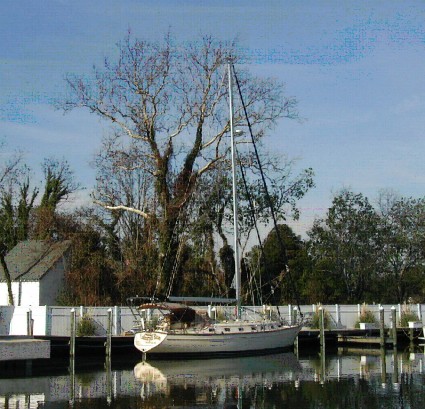
When we took the boat to be hauled in Hampton, Va. in the winter of 2003, the marina had never hauled a "full keeled" sailboat. They invited a legion of people to consult. One person had spent some years restoring and sailing the square rigged replica vessel, "Discovery,".in historic Jamestown. In asking about the name and after hearing the story, he offered that "it probably is "cat-harpings" rather than Catharpin. The cat-harpings were part of the rigging for square rigger sailing ships and were used to allow the yard arms to enable the vessel to sail upwind."
When we sailed with the Caribbean 1500 in 2006, one of the other ralliers asked if we had looked it up in "The Sea of Words." When we said no, they brought it out and we found the entry:
"Cat-harpings: Small ropes that brace the SHROUDS of the lower MASTS under the TOP of SQUARE-RIGGED vessels. Until about 1820, the FUTTOCK SHROUDS were secured to the lower shrouds and futtock-STAVES rather than to the lower mast. To assist in securing the TOPMAST ropes were snaked between the futtock-staves and FRAPped together to form cat-harpin legs. Later the cat-harpin legs were short lengths of heavy rope with an eye at each end and served throughout their length. Since the cat-harpins pulled the lower shrouds in a little, this facilitated the bracing up of the lower yard. In Young Sea Officer's Sheet Anchor, Darcy Lever illustrates a variation, in which the cat harpings cross, forming an X. This is the source of Patrick O'Brian's cross cat-harpings."
When we ran across another rallier who also asked about the name, he asked if we had looked in Ashley's Book of Knots. Their entry states:
"Catharpins (are a knot that) stiffened the backstays by frapping them to the tops, and were a variety of the crowfoot. The ends were spliced and seized similarly to "ratlines". Sometimes they had a euphroe block, at other times they were merely lashed. Catharpins were still to be seen occasionally at the turn of the present century."
When we sailed with the Caribbean 1500 in 2006, one of the other ralliers asked if we had looked it up in "The Sea of Words." When we said no, they brought it out and we found the entry:
"Cat-harpings: Small ropes that brace the SHROUDS of the lower MASTS under the TOP of SQUARE-RIGGED vessels. Until about 1820, the FUTTOCK SHROUDS were secured to the lower shrouds and futtock-STAVES rather than to the lower mast. To assist in securing the TOPMAST ropes were snaked between the futtock-staves and FRAPped together to form cat-harpin legs. Later the cat-harpin legs were short lengths of heavy rope with an eye at each end and served throughout their length. Since the cat-harpins pulled the lower shrouds in a little, this facilitated the bracing up of the lower yard. In Young Sea Officer's Sheet Anchor, Darcy Lever illustrates a variation, in which the cat harpings cross, forming an X. This is the source of Patrick O'Brian's cross cat-harpings."
When we ran across another rallier who also asked about the name, he asked if we had looked in Ashley's Book of Knots. Their entry states:
"Catharpins (are a knot that) stiffened the backstays by frapping them to the tops, and were a variety of the crowfoot. The ends were spliced and seized similarly to "ratlines". Sometimes they had a euphroe block, at other times they were merely lashed. Catharpins were still to be seen occasionally at the turn of the present century."
Cat-harping
01 March 2002 | Virginia

We have determined that cat-harpings are not used on all square riggers. We first saw examples of these cat-harpings on the sailing ship "Deliverance" (John Smith's, of Jamestown fame, boat) in St George Harbor in Bermuda. We also talked to the historian at the USS Constitution in Boston, MA. He stated that, whereas the Constitution does not have cat-harpings, the Essex (a ship from the same era) does. In fact the historian had a model of the Essex and showed us how they were rigged and used.
And the story goes on. We went to Jamestown, Va. and visited the models of the ships that carried the first settlers to Virginia - including the "Discovery". Sure enough, these ships have Catharpings, like we were told, - and again we were able to see life sized examples in the rigging.
Another possible explanation comes again from another rallier. He speculates:
"From my OED (Oxford English Dictionary): For catharpins, see harpins. Harpins: 1) the fore parts of the wale which encompass the bow of a ship....
Cat-harpings: The ropes or (now more generally) iron clamps that serve to brace in the shrouds of the lower-masts behind their respective yards, so as to tighten the shrouds and also give more room to draw the yards in when the ship is close-hauled.
Now here's my (possible) explanation of what they are talking about: Imagine a sloop with a shroud on each side of the mast. Now hang a square-yard from the mast, somewhat below the spreaders. Now drop a sail from that yard. All well and good when running dead downwind, but if you want to head up at all, you would want to brace the yard, or swing it around somewhat so the port side of the sail - and the port side of the yard - is forward of the mast when the wind is on the port side. The downwind (starboard) side of the sail would be more aft, and the portion of the yard above it would also be pulled aft, but it could interfere with the shroud on the starboard side. If you were to slack that leeward shroud (not much need for tension on it, as it is to lee), then you would be able to brace the spar more aft on that side. But you might not want to make that shroud slack, you might just want to pull it aft to give room for the spar to be pulled aft on that side. So, you get catharpins to hook onto the shroud and pull it aft, similar to pulling on the string of a bow (and arrow). Since pulling on only one point on the shroud would put tension on just one point, one would be better off having something like a saddle that is curved, so the pulling point is not a point but a length of the shroud. Since something like that would have been difficult to make in the 17th century, a bunch of finger-like pieces of iron (or iron clamps in the definition), joined together at one end and bent like fingers could hook onto the shroud and distribute the tension. "
Subsequently, looking on the internet we found some conversation relating to the origins of Cat-Harping":
David Steel: *Elements of Mastmaking, Sailmaking & Rigging* defines
Swigging off: 'Pulling upon the middle of a tight rope which is made fast
at both ends.' Getting a taut rope even tighter in this way is well known
to every practical sailor, and a grasp of the underlying principle it is
basic to an understanding of the working of cat-harpings.
After about 1820, it became the practice to secure the futtock shrouds to a
collar or necklace on the lower mast. They were independent of the lower
shrouds, and with the topmast shrouds supported the topmast, and one can
think of the top and crosstrees functioning as a sort of strut transforming
some of the downward pull of topmast and futtock shrouds into a lateral
component. Earlier, however, the futtocks were secured not to the mast but
to the futtock staves and lower shrouds. If the latter became slack, not
only was the lower mast less secure, but the tendency of the topmast to
whip if the vessel were rolling heavily was increased.
Things were stiffened up by the catharpings, which were rigged in various
ways. Johann Röding *Allgemeines Wörterbuch der Marine* (c.1794), shows
three different ways of snaking the catharping back and forth from one side
to the other, and then getting everything taut by frapping the turns one to
another (the 'swigging' idea again. A later method used 'Catharping legs'.
Steel *Elements of mastmaking Sailmaking and Rigging*(1794) describes them
thus: "Catharpin-legs are four in number. The foremost is the shortest, and they
increase one inch in length as they go aft. The length of the foremost is
from four feet in small ships to eight feet in large. They have an eye
spliced in each end for lashing, and are then wormed parcelled and served
from eye to eye."
These (legs) were seized to the lower shrouds, at the level of the futtock
shrouds, so they could not separate, even if the ship were rolling heavily.
Iron bars were sometimes substituted for rope. In any case, a major
function of the cat-harpings was to support the topmast. Once the futtocks
were secured to a necklace on the mast, catharpings fell into desuetude.
William Brady in *The Kedge-Anchor* (1852), saying they are seldom used,
and considered 'useless lumber aloft'.
It will be noted that, once set up, the catharpings were not constantly
readjusted, and it was important that they be set up bar-taut initially.
This could have been accomplished be slackening off the shrouds, and then
setting them up tight again with the dead-eye lanyards, but another method
was to use a 'swifter'.
Cat-harpings could also improve the trim of the lower yard. When sailing by
the wind, the square canvas worked to best advantage, if the yard from
which it was deployed was as sharp as possible. In the case of the fore
topsail, traverse was limited to about 30 degrees from the fore-and-aft
line, by the foretopmast stay. When the sail was set, the yard was almost
level with the eyes of the topmast-shrouds, and the lee shrouds did not
really interfere with the yard. Things were different with fore yard,
which was hung relatively lower, with regard to the masthead and the eyes
of the shrouds. Travel was limited not just by the forestay, forward of the
yard, but by the foremost lee shroud abaft it. Traverse could be increased
a little by hauling taut the lee lift; by adjusting the trusses, slacking
the weather one, and hauling the lee one taut; but in our particular
context, the forward lower shroud could be pulled in; pulled back; or
slacked off.
In Elizabethan days, the foremost shroud or 'Swifter', was actually a
tackle. Mainwaring says that they 'do belong to the main and foremast, and
are to succour the shrouds and keep stiff the mast. They have pendants,
which are made fast under the shrouds, at the head of the mast, with a
double-block, through which is reeved the swifter, which at the standing
part hath a single-block with a hook, which is hitched in a ring by the
chain-wales. And so the fall being hauled, doth help to strengthen the
mast.' Later on, it appears that the foremost shroud was never cat-harped
..... presumably so it could be slacked off.
The hyphenated examples of the word suggest that it was pronounced 'Cat'+'Harping' and not 'Cath'+'Arping'. Modern marine lexicographers for the most part follow Blankely (1750) and Lever (1808), spelling it as one word, but it is
hyphenated in modern reprints of dictionaries"
Over the years, Catharpin Blue has logged over 15000 miles with a trip to Maine, two trips to the Caribbean from the Chesapeake Bay and now is located in Colon, Panama in preparation for a Panama Canal crossing and beyond. Even though she has no catharpings in her rigging, she is following the paths of early ocean travelers who did have them in their rigging.
And the story goes on. We went to Jamestown, Va. and visited the models of the ships that carried the first settlers to Virginia - including the "Discovery". Sure enough, these ships have Catharpings, like we were told, - and again we were able to see life sized examples in the rigging.
Another possible explanation comes again from another rallier. He speculates:
"From my OED (Oxford English Dictionary): For catharpins, see harpins. Harpins: 1) the fore parts of the wale which encompass the bow of a ship....
Cat-harpings: The ropes or (now more generally) iron clamps that serve to brace in the shrouds of the lower-masts behind their respective yards, so as to tighten the shrouds and also give more room to draw the yards in when the ship is close-hauled.
Now here's my (possible) explanation of what they are talking about: Imagine a sloop with a shroud on each side of the mast. Now hang a square-yard from the mast, somewhat below the spreaders. Now drop a sail from that yard. All well and good when running dead downwind, but if you want to head up at all, you would want to brace the yard, or swing it around somewhat so the port side of the sail - and the port side of the yard - is forward of the mast when the wind is on the port side. The downwind (starboard) side of the sail would be more aft, and the portion of the yard above it would also be pulled aft, but it could interfere with the shroud on the starboard side. If you were to slack that leeward shroud (not much need for tension on it, as it is to lee), then you would be able to brace the spar more aft on that side. But you might not want to make that shroud slack, you might just want to pull it aft to give room for the spar to be pulled aft on that side. So, you get catharpins to hook onto the shroud and pull it aft, similar to pulling on the string of a bow (and arrow). Since pulling on only one point on the shroud would put tension on just one point, one would be better off having something like a saddle that is curved, so the pulling point is not a point but a length of the shroud. Since something like that would have been difficult to make in the 17th century, a bunch of finger-like pieces of iron (or iron clamps in the definition), joined together at one end and bent like fingers could hook onto the shroud and distribute the tension. "
Subsequently, looking on the internet we found some conversation relating to the origins of Cat-Harping":
David Steel: *Elements of Mastmaking, Sailmaking & Rigging* defines
Swigging off: 'Pulling upon the middle of a tight rope which is made fast
at both ends.' Getting a taut rope even tighter in this way is well known
to every practical sailor, and a grasp of the underlying principle it is
basic to an understanding of the working of cat-harpings.
After about 1820, it became the practice to secure the futtock shrouds to a
collar or necklace on the lower mast. They were independent of the lower
shrouds, and with the topmast shrouds supported the topmast, and one can
think of the top and crosstrees functioning as a sort of strut transforming
some of the downward pull of topmast and futtock shrouds into a lateral
component. Earlier, however, the futtocks were secured not to the mast but
to the futtock staves and lower shrouds. If the latter became slack, not
only was the lower mast less secure, but the tendency of the topmast to
whip if the vessel were rolling heavily was increased.
Things were stiffened up by the catharpings, which were rigged in various
ways. Johann Röding *Allgemeines Wörterbuch der Marine* (c.1794), shows
three different ways of snaking the catharping back and forth from one side
to the other, and then getting everything taut by frapping the turns one to
another (the 'swigging' idea again. A later method used 'Catharping legs'.
Steel *Elements of mastmaking Sailmaking and Rigging*(1794) describes them
thus: "Catharpin-legs are four in number. The foremost is the shortest, and they
increase one inch in length as they go aft. The length of the foremost is
from four feet in small ships to eight feet in large. They have an eye
spliced in each end for lashing, and are then wormed parcelled and served
from eye to eye."
These (legs) were seized to the lower shrouds, at the level of the futtock
shrouds, so they could not separate, even if the ship were rolling heavily.
Iron bars were sometimes substituted for rope. In any case, a major
function of the cat-harpings was to support the topmast. Once the futtocks
were secured to a necklace on the mast, catharpings fell into desuetude.
William Brady in *The Kedge-Anchor* (1852), saying they are seldom used,
and considered 'useless lumber aloft'.
It will be noted that, once set up, the catharpings were not constantly
readjusted, and it was important that they be set up bar-taut initially.
This could have been accomplished be slackening off the shrouds, and then
setting them up tight again with the dead-eye lanyards, but another method
was to use a 'swifter'.
Cat-harpings could also improve the trim of the lower yard. When sailing by
the wind, the square canvas worked to best advantage, if the yard from
which it was deployed was as sharp as possible. In the case of the fore
topsail, traverse was limited to about 30 degrees from the fore-and-aft
line, by the foretopmast stay. When the sail was set, the yard was almost
level with the eyes of the topmast-shrouds, and the lee shrouds did not
really interfere with the yard. Things were different with fore yard,
which was hung relatively lower, with regard to the masthead and the eyes
of the shrouds. Travel was limited not just by the forestay, forward of the
yard, but by the foremost lee shroud abaft it. Traverse could be increased
a little by hauling taut the lee lift; by adjusting the trusses, slacking
the weather one, and hauling the lee one taut; but in our particular
context, the forward lower shroud could be pulled in; pulled back; or
slacked off.
In Elizabethan days, the foremost shroud or 'Swifter', was actually a
tackle. Mainwaring says that they 'do belong to the main and foremast, and
are to succour the shrouds and keep stiff the mast. They have pendants,
which are made fast under the shrouds, at the head of the mast, with a
double-block, through which is reeved the swifter, which at the standing
part hath a single-block with a hook, which is hitched in a ring by the
chain-wales. And so the fall being hauled, doth help to strengthen the
mast.' Later on, it appears that the foremost shroud was never cat-harped
..... presumably so it could be slacked off.
The hyphenated examples of the word suggest that it was pronounced 'Cat'+'Harping' and not 'Cath'+'Arping'. Modern marine lexicographers for the most part follow Blankely (1750) and Lever (1808), spelling it as one word, but it is
hyphenated in modern reprints of dictionaries"
Over the years, Catharpin Blue has logged over 15000 miles with a trip to Maine, two trips to the Caribbean from the Chesapeake Bay and now is located in Colon, Panama in preparation for a Panama Canal crossing and beyond. Even though she has no catharpings in her rigging, she is following the paths of early ocean travelers who did have them in their rigging.
| Vessel Name: | Catharpin Blue |
| Vessel Make/Model: | Island Packet 420 |
| Hailing Port: | Deltaville, Va |
| Crew: | Sam Fowler |
| About: | Marilyn Hilbers |
| Extra: |
Catharpin Blue's Photos - Main
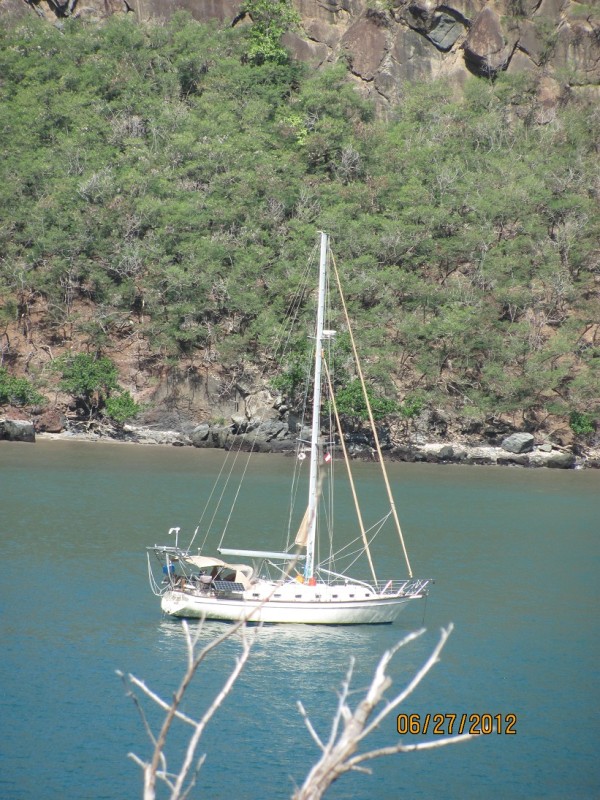 |
Activities in Panama, Galapagos, Polynesia, Niue, Tonga and New Zealand a
1 Photo | 9 Sub-Albums
Created 20 March 2012
|
Catharpin Blue
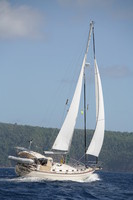
Who: Sam Fowler
Port: Deltaville, Va
.jpg)
.jpg)
.jpg)
.jpg)
.jpg)
.jpg)

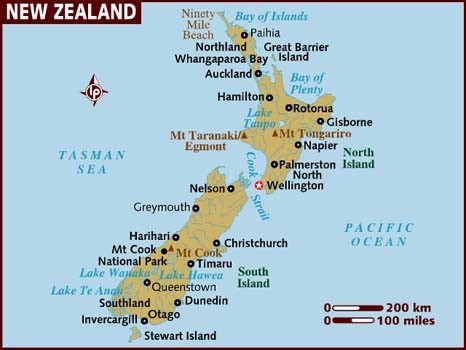

.jpg)
.jpg)
.jpg)
.jpg)
.jpg)
